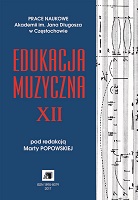II Koncert fortepianowy Andrzeja Nikodemowicza
– poszukiwanie oryginalnego brzmienia
Andrzej Nikodemowicz’ Piano Concerto no. 2
– Search for the Original Sound
Author(s): Ewa NideckaSubject(s): Music
Published by: Uniwersytet Jana Długosza w Częstochowie
Keywords: Andrzej Nikodemowicz; Andrzej Nikodemowicz' Piano Concerto no.2; Polish composers’ works in the first decade of the 21st century; lyricism and expression.
Summary/Abstract: The piano concertos by the Polish composer Andrzej Nikodemowicz (1925–2017) belong tothe late and mature period of his creativity. The Piano Concerto no. 2 discussed in this article wascomposed in 2002 and is in fact the first autonomous concerto composed for the piano by thisartist, as his Piano Concerto no.1 (1994) is a modification of his own Violin Concerto written in1973. The piece was being conceived with a sense of stability and full creative freedom. Living inPoland, in Lublin since 1980, the composer no longer felt the psychological pressure that he hadbeen experiencing during his stay in Lviv. Due to the regime ruling there, most of the works createdin Lviv had no chance of being performed.As far as the structure is considered, in the Piano Concerto No. 2, the composer abandoned theclassical three-movement structure and the symmetrical arrangement, which he had favoured inmany of his compositions, in favour of the constrasting parts form. The Piano Concerto No. 2makes apparent the overlapping of two trends connected with the rules of shaping musical material.One of them is a tradition with neo-romantic roots, expressive and lyrical, but undergoinga significant transformation of its own vision, the other uses the energy of the rhythm and thepercussive properties of the piano. The composer uses a strongly dissonant 12-tone sound materialand complex rhythmic divisions, complementary rhythms, thus creating a dense sound structure.Ultimately, they contain a recognizable stylistic idiom, the essence of which is lyricism and expression.It is the result of a permanent variability and diversity and the application of developmentat the microform stage. The major aim of the compositional technique is to achieve a sublimesound. The development factor is one of the main features of Andrzej Nikodemowicz’ style
Journal: Edukacja Muzyczna
- Issue Year: 2017
- Issue No: 12
- Page Range: 83-100
- Page Count: 18
- Language: Polish

